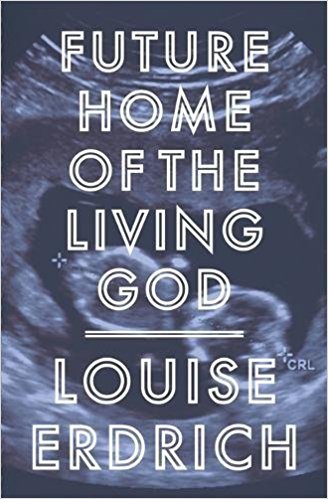You have no items in your cart. Want to get some nice things?
Go shopping
Future Home of the Living God, Louise Erdrich’s latest novel and a foray into speculative fiction, takes the idea of a ‘retrieval of history’ seriously – not just in its pale liberal version (‘memory’), but as the thuddingly physical possibility that creatures from a previous stage of evolutionary history will begin to be born. This is the universe entering ‘deep time’, as a television host explains. Erdrich does not go into much scientific detail about how this works, but we get the gist – mutation has occurred within the replications contained by genomes. Encoded in each piece of DNA is an archival history of its own past versions, and for an unknown reason these past versions have started once again to emerge. Biological evolution is now running in reverse, such that babies resemble creatures from a prior stage, millions of years before.
What this means in practice is that primeval beings like oversized dragonflies and big cats fond of a chocolate Labrador snack have begun to appear. Human mothers are giving birth to babies that are somehow ‘off’, or more primitive, than previously. For the government, this poses a threat to ordinary humanity – and so all pregnant women are forcibly being rounded up. ‘Gravid female detentions’ take place, and women who do not go voluntarily are led by coercion to a hospital or jail, to be monitored. A female womb draft begins, and some women are compelled to carry to term a frozen embryo from an old in-vitro clinic, or inseminated with sperm from an old sperm bank. The climate itself is changing, so that the world seems set to end in a deep freeze, described in magnificent language highly reminiscent of Doris Lessing’s science fiction cycle.
As a dystopia the book is an exaggerated version of Bush-era politics. The villain becomes the government, informed by a sort of Christian evangelicalism that is prepared to replace street names with Bible verses once it takes power. A familiar Apocalypse reigns. People stock up on food at supermarkets, buy guns, take out money from the bank and purchase gallons of alcohol, to resell for later profit when stress levels rise even higher. The food that accompanies these end times is the kind made for survival – mostly junk, from Ramen to Twinkies. When a ‘Mother’ apparition from the government begins to appear on screens, people throw out their computers and phones so as not to be tracked, reverting the world to a near pre-technological condition.
In such circumstances, the relationship between individual perception and objective reality is continuously put into doubt, and the truth value of news begins to shimmer. ‘And yet … there is something about this wash of information that strikes me as too much, and what I mean by that is the information seems flimsier, with bouts of … cuteness,’ Cedar Hawk Songmaker, the narrator, writes. Without reliable sources, hearsay is all that people have to go on. ‘I don’t know whether to believe these things, but here I am.’
Cedar Hawk is four months pregnant, and in addition to the end times, she is dealing with fall-out from a reconnection with her Ojibwe origins, after growing up with adopted parents in Minnesota. When she visits the reservation, she quickly finds that it has problems with casinos, meth use and battles over land, and there’s a certain omnipresent kitsch in everything from the fiberglass eagle to the saint statues. Even so, the place is the kind of community she’s craving. Who cares if the sacred symbols are worn out and co-exist with the reservation’s smell of gasoline and taste of chemically-flavoured hot dogs?
There is a healthy ambiguity with respect to the Native American culture here, a kind of home both for Erdrich (whose previous novels all take place in this context) and for her creation, Cedar Hawk. Erdrich knows the culture well enough to know its flaws too, and she ironizes certain aspects. Before going to meet her Native family, for instance, Cedar Hawk says that she’d always imagined them to have ‘died in some vague and suitably spiritual Native way – perhaps fasting themselves to death or sundancing to heatstroke or plunging off a cliff for love or being carried off by thunderbirds?’
Cedar Hawk, in fact, is more deeply connected in the sacred sense to a certain Catholic mysticism, which flows through the book, beginning with its epigraph by Hildegard von Bingen. In times of stress, Cedar Hawk reads a biography of Bingen by Sabina Flanagan, as well as Is That in the Bible? by Dr Charles Francis Potter, Raids on the Unspeakable by Thomas Merton, Dark Night of the Soul by St John of the Cross, The Life of Kateri Tekakwitha by Evelyn M. Brown and Utterly Mad by William Gaines. She sees her baby’s ultrasound in mystical terms; watching blood enter and exit the heart, she notes that ‘the outflow is gold fire and the inflow is blue fire’. As the world becomes timeless time, the stopped moment of wonder during which Cedar Hawk views her baby onscreen seems a microcosm for the world’s changes. ‘I am not at the end of things, but the beginning,’ she says. Apocalypse and Genesis are linked; this is the moment of the eternal ‘now’.
Yet the question of what, actually, to do during this ‘now’ moment of apocalypse is a pressing one. What really matters, what should one focus on? Are the land grabs by Native Americans, correcting some historical injustice, all that important if the world is going to end, or is universal biological change such an abstract and unpredictable concept that one might as well hold to one’s local ideals? As in many dystopias, the constant external anxiety results in a renewed appreciation for ordinary things, such as comfort foods like pancakes and hot raspberry tea (‘good for the uterus’), hand massages, domestic kitsch and the contemplation of nature. ‘I walk out to the kitchen, pour a glass of antibiotic-free milk, and drink it looking out at the bursts of zinnias, daisies, lythrum and digitalis in the yard,’ says Cedar Hawk.
To acknowledge and cool the occasional absurdity of the plot and its mystical solemnity is necessary, however, and Erdrich does insert humour, to the point that some scenes verge on pulp. The second part of the book reads like a thriller, including a murder scene from a kung fu movie abetted by Cedar Hawk’s roommate ‘Spider Nun’ (real name: Tia Jackson), ending so: ‘At last her legs relax and splay open and she is dead.’ The murder may have emotional consequences, but it is described as black comedy.
One could go on. There is a note that arrives in code to a claustrophobic hospital environment where women are dubbed ‘preggerpots’, and must be deciphered using the Bible. There is a horror film sequence involving rats nibbling at a stillborn baby, which fades away: ‘The horror is reduced to a bitter aura, more like a dream.’ There is an operational underground network based from the postal service and recycling plants, where as someone reassuringly notes: ‘But we’ve got caves behind the caves, you know? Those lead into a labyrinth of tunnels. St Paul sits on top of a whole other world.’ No wonder Cedar Hawk notes: ‘I am on edge because who wouldn’t be?’ and speaks of ‘this freakish sense of continual paranoia’.
The novel begins as a traditional first-person narrative before taking the format of diary entries written by the future mother to her baby, as a witness chronicle, or as she puts it, ‘a record and an inquiry into the strangeness of things’. This mad scribbling in a notebook is in part done for her own sanity, out of a desire for coherent narrative. Throughout the book, chapters of a work-in-progress are included by Cedar Hawk’s Native American grandfather, with daily reasons not to commit suicide, tentatively titled Why Not to Kill Yourself; there are also columns on Hans Küng and incarnation for Cedar Hawk’s church newsletter Zeal.
As Cedar Hawk talks about her fights with her adopted mom Sera, her memories of a husband who betrayed her after being tortured and her experience of a hospital breakout/breakdown, one wonders about the constants in her life – the commitment to her baby and to a mystical appreciation of beauty. ‘I think we have survived because we love beauty and because we find each other beautiful. I think it may be our strongest quality,’ she writes. She enthuses about such moments as seeing ‘clouds with a blaze of gold lace’, and says: ‘Dear baby, I want you to see this world, supernal, lovely, I want this world to fill your eyes.’ That the baby is always in her thoughts is revealed in some heavy-handed references, such as to a painting of a pomegranate and water glass (‘either empty or full to the brim’), where ‘the two objects sit, one ripening, upon a tabletop that stretches into the shadows.’
Future Home of the Living God is a sophisticated treatment of a dystopian vision, but do we really need another dystopia? Perhaps so, if as Erdrich is attempting, it challenges the shaky nature of everything. One of the most tantalizing suggestions, that thought itself could revert to past modes, favouring primitive forms, myths, pre-verbal language and rites over forward-progressing scientific thinking, is alluded to but not developed. Cedar Hawk writes of her Native American grandmother that: ‘I imagine her mind as a pinball machine, one of the old-fashioned, nonelectronic kind. A thought ricochets over a century of personal memory, lighting up and ringing associations that only connect because of the speed and arbitrary motion of the original thought.’ Can the mind, too, turn back to a previous stage of thinking in the evolutionary process? What would this be like? Would it be a good thing?
A more ‘primitive’ form of thinking may be more visual than verbal, and perhaps a quasi-religious comfort exists in considering the world in terms of a unifying image. Why not the ladder? ‘In darkness and secure, by the secret ladder, disguised,’ wrote St John of the Cross. In Future Home of the Living God, a literal ladder is woven out of blankets, and two pregnant women use it to rappel down the side of a hospital building, in flight. Strands of DNA also take the form of a twisting ladder, and finally there is Time itself – a ladder it is possible to climb up, perhaps, but also back down.
Future Home of the Living God is published by Corsair.

About Jessica Sequeira
Jessica Sequeira is a writer and translator from California, currently living in Santiago de Chile.





I love the book “The horror is reduced to a bitter aura, more like a dream”. It completely based on some postal service.
I have just completed the half book and I’m so excited to complete fully. Very interesting Story we can feel pain during reading.
I have just completed the half book and I’m so excited to complete fully. Very interesting Story we can feel pain during reading.